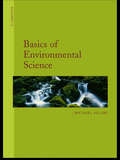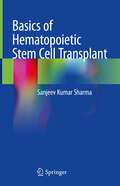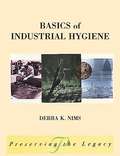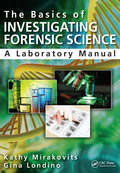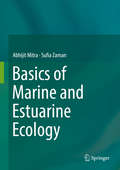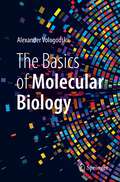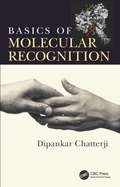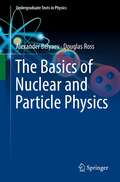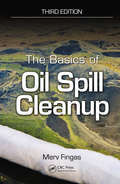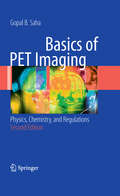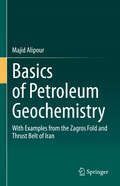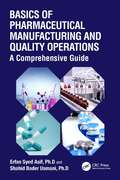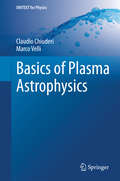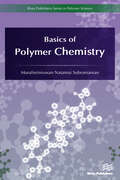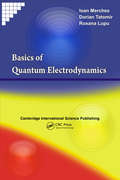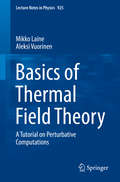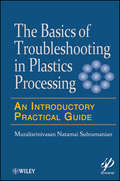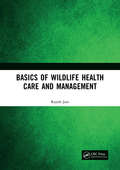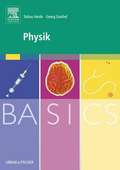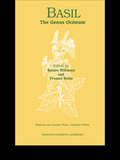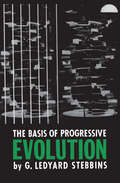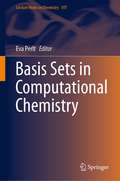- Table View
- List View
Basics of Environmental Science
by Michael AllabyThe new edition of this popular student text offers an engaging introduction to environmental study. It covers the entire breadth of the environmental sciences, providing concise, non-technical explanations of physical processes and systems and the effects of human activities. In this second edition the scientific background to major environmental issues is clearly explained. These include:* global warming* genetically modified foods* desertification* acid rain* deforestation* human population growth * depleting resources* nuclear power generation* descriptions of the 10 major biomes. Special student text features include illustrations and explanatory diagrams, boxed case studies, concepts and definitions.
Basics of Flow Microreactor Synthesis (SpringerBriefs in Molecular Science)
by Jun-Ichi YoshidaThis book provides in a concise form the principles and applications of flow microreactors in organic and polymer synthesis. Recently, it became possible to conduct chemical reactions in a flow reactor in laboratory synthesis. The flow microreactor enables reactions that cannot be done in batch, opening a new possibility of chemical synthesis. Extremely fast mass and heat transfer and high-resolution residence time control are responsible for the remarkable features of that process. The book is not an exhaustive compilation of all known examples of flow microreactor synthesis. Rather, it is a sampling of sufficient variety to illustrate the concept, the scope, and the current state of flow microreactor synthesis. Researchers both in academia and in industry will be interested in this book because the topics encompassed by the book are vigorously studied in many university and company laboratories today.
Basics of Hematopoietic Stem Cell Transplant
by Sanjeev Kumar SharmaThis book is quick guide on the hematopoietic stem cell transplant (SCT), also called bone marrow transplant (BMT) - an evolving field of hematology and hemato-oncology. This book covers the various types of stem cell transplants like autologous and allogeneic stem cell transplants, indications, ways of doing a transplant, and stem cell transplants basic principles. Written in a question-answer format, readers will find it more interesting as one question sequentially leads to another. This book explains the complications of SCT in individual chapters along with the biology of T cells which are the most important cells involved in the success of SCT This book is beneficial to the budding hematologists, oncologists, and postgraduates interested in SCT and helps students in their exams. The book would be helpful for readers globally as SCT is a procedure done worldwide and is an ever-increasing field for treating various benign and malignant hematological diseases.
Basics of Image Processing: The Facts and Challenges of Data Harmonization to Improve Radiomics Reproducibility (Imaging Informatics for Healthcare Professionals)
by Ángel Alberich-Bayarri Fuensanta Bellvís-BatallerThis book, endorsed by EuSoMII, provides clinicians, researchers and scientists a useful handbook to navigate the intricate landscape of data harmonization, as we embark on a journey to improve the reproducibility, robustness and generalizability of multi-centric real-world data radiomic studies. In these pages, the authors delve into the foundational principles of radiomics and its far-reaching implications for precision medicine. They describe the different methodologies used in extracting quantitative features from medical images, the building blocks that enable the transformation of images into actionable predictions. This book sweeps from understanding the basis of harmonization to the implementation of all the knowledge acquired to date, with the aim of conveying the importance of harmonizing medical data and providing a useful guidance to enable its applicability and the future use of advanced radiomics-based models in routine clinical practice. As authors embark on this exploration of data harmonization in radiomics, they hope to ignite discussions, foster new ideas, and inspire researchers, clinicians, and scientists alike to embrace the challenges and opportunities that lie ahead. Together, they elevate radiomics as a reproducible technology and establish it as an indispensable and actionable tool in the quest for improved cancer diagnosis and treatment.
Basics Of Industrial Hygiene
by Debra NimsThis book provides environmental technology students with an enjoyable way to quickly master the basics of industrial hygiene. Like all the books in the critically acclaimed Preserving the Legacy series, it follows a rapid-learning modular format featuring learning objectives, summaries, chapter-end reviews, practice questions, and skill-building classroom activities. Throughout the text, sidebars highlight critical concepts, and more than 90 high-quality line-drawings, photographs, and diagrams help to clarify concepts covered. Author Debra Nims begins with a fascinating historical overview of the art and science of industrial hygiene, followed by a concise review of key concepts and terms from biology and toxicology. She then offers in-depth practical coverage of: * Identifying hazards or potential hazards * Sampling and workplace evaluations * Hazard control * Toxicology, occupational health, and occupational health standards * Airborne hazards * Dermatoses and contact hazards * Fire and explosion hazards * Occupational noise * Radiation * Temperature extremes * Repetitive use traumas With its comprehensive coverage and quick-reference format, Basics of Industrial Hygiene is also a handy refresher and working reference for practicing environmental technicians and managers.
The Basics of Investigating Forensic Science: A Laboratory Manual
by Kathy Mirakovits Gina LondinoOnce confined to four-year colleges and graduate schools, forensic science classes can now be found in local high schools as well as in two-year community colleges. The Basics of Investigating Forensic Science: A Laboratory Manual is designed for the beginning forensic science student and for instructors who wish to provide a solid foundation in ba
Basics of Marine and Estuarine Ecology
by Abhijit Mitra Sufia ZamanThe book presents recent research on marine ecology in different parts of the world. It aims to shed light on relevant topics for budding marine ecologists. The "blue soup" of Planet Earth, which comprises both biotic and abiotic components, is essential to keeping the wheel of civilization running. Four major ecosystem service categories have been identified within this context, namely provisioning services such as water, food, mangrove timber, honey, fish, wax, fuel wood, fodder and bioactive compounds from marine and estuarine flora and fauna; regulating services such as the regulation of climate, coastal erosion, coral bleaching and pollution; cultural services encompassing recreational (tourism), spiritual and other non-material benefits; and supporting services such as nutrient cycling and photosynthesis. These valuable services are obtained from various resources that must be conserved for the sake of humanity. This book presents data for each resource type, not just in the form of a simple description, but also through case studies that resulted from several research projects and pilot programs carried out in different parts of the world. Statistical tools were also used to critically analyze the influence of relevant hydrological parameters on the biotic community. Advanced research in marine and estuarine ecology is based on the use of sophisticated instruments, sampling precision, statistical tools, etc. , which have also been highlighted in the book.
The Basics of Molecular Biology
by Alexander VologodskiiAccessible and comprehensive, this book describes the universal cellular nature of living organisms and is an indispensable tool for anyone in the sciences who wishes to get a quick overview of molecular biology. Individual chapters cover nucleic acids and proteins, genetic code and protein synthesis, the fidelity of transferring genetic information to the next generations, and the regulation of various processes inside the cells. Special attention is paid to new areas rising from modern DNA sequencing technologies which transform biology. The book also touches on developing areas, such as cures for cancer and CRISPR, which are important for medicine and the future of humankind.
Basics of Molecular Recognition
by Dipankar ChatterjiBasics of Molecular Recognition explores fundamental recognition principles between monomers or macromolecules that lead to diverse biological functions. Based on the author's longtime courses, the book helps readers understand the structural aspects of macromolecular recognition and stimulates further research on whether molecules similar to DNA o
The Basics of Nuclear and Particle Physics (Undergraduate Texts in Physics)
by Alexander Belyaev Douglas RossThis undergraduate textbook breaks down the basics of Nuclear Structure and modern Particle Physics. Based on a comprehensive set of course notes, it covers all the introductory material and latest research developments required by third- and fourth-year physics students. The textbook is divided into two parts. Part I deals with Nuclear Structure, while Part II delves into Particle Physics. Each section contains the most recent science in the field, including experimental data and research on the properties of the top quark and Higgs boson. Detailed mathematical derivations are provided where necessary to helps students grasp the physics at a deeper level. Many of these have been conveniently placed in the Appendices and can be omitted if desired. Each chapter ends with a brief summary and includes a number of practice problems, the answers to which are also provided.
The Basics of Oil Spill Cleanup
by Merv FingasReflecting the rapid progress in cleanup technology since the previous edition, this revised and expanded third edition of The Basics of Oil Spill Cleanup covers current cleanup techniques, how oil spills are measured and detected, and the properties of the oil and its long-term fate in the environment. It also deals with why, how often, and where
Basics of PET Imaging: Physics, Chemistry, and Regulations
by Gopal B. SahaThis is an ideal text on PET and PET/CT imaging technology that focuses on the basics, such as physics, instrumentation, production of PET radionuclides and radiopharmaceuticals, and regulations affecting PET. The chapters are concise but comprehensive, making the topic easily understandable, and they are complete with reviews of pertinent basic science, sample questions, and lists of suggested reading. Practical tables and appendixes contain a wealth of valuable data, reflecting the books usefulness as a reference for nuclear medicine professionals, including physicians, residents and technologists. The book also benefits technologists and residents preparing for board examinations because of its brevity and clarity of content.
Basics of Petroleum Geochemistry: With Examples from the Zagros Fold and Thrust Belt of Iran
by Majid AlipourThis book provides a concise summary about fundamental aspects of petroleum geology and geochemistry for graduate students, primarily from non-English-speaking countries. These fundamentals constitute about 40% of the book, while the remaining 60% deals with regional examples from petroleum geology of the Zagros basin of Iran. The regional examples are prepared using both published and unpublished (proprietary) data. The aim is to familiarize readers with the fundamental aspects of petroleum geochemistry and then provide typical examples from one of the world&’s most prolific petroleum provinces.
Basics of Pharmaceutical Manufacturing and Quality Operations: A Comprehensive Guide
by Erfan Syed Asif Shahid Bader UsmaniThis book provides guidance on how to meet the requirements of the pharmaceutical industry as a beginner. It includes procedures for production and packaging, batch auditing as well as all quality measures used in the pharmaceutical industry. This book also provides questions and answers with each chapter for institutes and trainers providing basic training to the new graduates and new comers to the industry.Basics of Pharmaceutical Manufacturing and Quality Operations: A Comprehensive Guide is primarily written for anyone in the pharmaceutical industry interested in development and manufacturing of active pharmaceutical ingredient (API) and finished pharmaceutical manufacturers in both sterile and non‑sterile areas. The book is a simple, concise, and easy to use reference tool covering basic quality concepts required by the pharmaceutical educational institutions and professional certification bodies. It describes details of all GXP activities that are directly related to Quality, Safety, and Efficacy of the products manufactured under the umbrella of Quality Operations, common testing methods which are used in any modern industry, Requirements of Validation and Qualification of equipment, facilities and processes, integral segments of Drug product manufacturing, storage, and distribution practices. The material provides stepwise guidance on how to evaluate, audit, qualify, and approve a pharmaceutical product to enhance the GMP within the industry.The book is written with the idea of providing basic knowledge to undergraduate students who are preparing to enter the industry at the end of their graduation. The book would also be beneficial for institutions conducting pharmaceutical technology study courses in terms of GMP and GLP applications.Features: Provides readers and front line health care product manufacturers, all the information they need to know to develop a GMP oriented industry with trained and skilled personnel and manufacture products that meet GMP and regulatory requirements. Provides stepwise guidance on how to evaluate, audit, qualify, and approve a pharmaceutical product and packaging material to enhance the GMP within the industry. Includes significant processes and steps in production for all common dosage forms. Explains how in‑process and finished products are released. Provides an ideal and effective tool for anyone starting Quality Assurance/Quality control/Production responsibilities.
Basics of Plasma Astrophysics (UNITEXT for Physics)
by Claudio Chiuderi Marco VelliThis book is an introduction to contemporary plasma physics that discusses the most relevant recent advances in the field and covers a careful choice of applications to various branches of astrophysics and space science. The purpose of the book is to allow the student to master the basic concepts of plasma physics and to bring him or her up to date in a number of relevant areas of current research. Topics covered include orbit theory, kinetic theory, fluid models, magnetohydrodynamics, MHD turbulence, instabilities, discontinuities, and magnetic reconnection. Some prior knowledge of classical physics is required, in particular fluid mechanics, statistical physics, and electrodynamics. The mathematical developments are self-contained and explicitly detailed in the text. A number of exercises are provided at the end of each chapter, together with suggestions and solutions.
Basics of Polymer Chemistry
by Muralisrinivasan Natamai SubramanianBasics of Polymer Chemistry is of great interest to the chemistry audience. The basic properties of polymers, including diverse fundamental and applied aspects, are presented. This book constitutes a basis for understanding polymerization, and it presents a comprehensive overview of the scientific research of polymers. The chapters presented can be used as a reference for those interested in understanding the sustainable development in polymers.Basics of Polymer Chemistry provides a balanced coverage of the key developments in this field, and highlights recent and emerging technical achievements. The topics covered present a comprehensive overview of the subject area and are therefore of interest to professors and students. The recent developments in polymerization using catalysts, homo and copolymerization are presented, and it contains current efforts in designing new polymer architectures. Improved property performance attributes of the polymers by controlling their molecular-structural characteristics such as molecular weight distribution, comonomer type content distribution, and branching level are also discussed.
Basics of Quantum Electrodynamics
by Ioan Merches Dorian Tatomir Roxana E. LupuQuantum electrodynamics (QED) is the branch of relativistic quantum field theory that deals specifically with the interactions between charged particles. It is widely used to solve problems in many areas of physics, such as elementary particles, atomic and molecular systems, and solid state physics. This accessible text, Basics of Quantum Electrody
Basics of Social Research: Qualitative and Quantitative Approaches (Third Edition)
by W. Lawrence NeumanPreparing students to do research and understand what research can do. Basics of Social Research helps students understand what research can and cannot do, become better consumers of research, and learn why properly conducted research is important. This text teaches students to be better consumers of research results and understand how the research enterprise works, preparing them to conduct small research projects. Upon completing this text, students will gain an awareness of the capabilities and restrictions of research, and learn why properly conducted research is important. Using clear, accessible language and examples from real research, this text discusses both qualitative and quantitative approaches to social research, emphasizing the benefits of combining various approaches. Learning Goals Upon completing this book, readers should be able to: Recognize that social research is simultaneously a very important enterprise and one that is not beyond you -- you can understand it Become better consumers and understand what research can and cannot do Learn how to properly conducted research Acquire a foundation for further learning about doing research and understand that this activity requires dedication, creativity, and mature judgment Note: MySearchLab does not come automatically packaged with this text. To purchase MySearchLab, please visit: www. mysearchlab. com or you can purchase a ValuePack of the text + MySearchLab with Pearson eText (at no additional cost). ValuePack ISBN-10: 0205863671/ ValuePack ISBN-13: 9780205863679
Basics of Thermal Field Theory: A Tutorial on Perturbative Computations (Lecture Notes in Physics #925)
by Mikko Laine Aleksi VuorinenThis book presents thermal field theorytechniques, which can be applied in both cosmology and the theoreticaldescription of the QCD plasma generated in heavy-ion collision experiments. Itfocuses on gauge interactions (whether weak or strong), which are essential inboth contexts. As well as the many differences in the physics questions posedand in the microscopic forces playing a central role, the authors also explainthe similarities and the techniques, such as the resummations, that are neededfor developing a formally consistent perturbative expansion. The formalism is developed step by step, startingfrom quantum mechanics; introducing scalar, fermionic and gauge fields; describingthe issues of infrared divergences; resummations and effective field theories;and incorporating systems with finite chemical potentials. With this machineryin place, the important class of real-time (dynamic) observables is treated insome detail. This is followed by an overview of a number of applications,ranging from the study of phase transitions and particle production ratecomputations, to the concept of transport and damping coefficients that play aubiquitous role in current developments. The book serves as a self-contained textbook on relativistic thermal field theoryfor undergraduate and graduate students of theoretical high-energy physics.
Basics of Troubleshooting in Plastics Processing: An Introductory Practical Guide (Wiley-Scrivener #51)
by Muralisrinivasan Natamai SubramanianThe Basics of Troubleshooting in Plastics Processing is a condensed practical guide that gives the reader a broad introduction to properties of thermoplastics plastics, additives, the major processes (extrusion, injection molding, rotational molding, blow molding, and thermoforming), as well as troubleshooting. The main goal is to provide the plastics processor with an improved understanding of the basics by explaining the science behind the technology. Machine details are minimized as the emphasis is on processing problems and the defects in an effort to focus on basic root causes to problems and how to solve them. The book’s framework is troubleshooting in plastics processing because of the importance it has to the eventual production of high quality end products. Each chapter contains both practical and detailed technical information. This basic guide provides state-of-the-art information on: Processing problems and defects during manufacturing Plastics materials, their properties and characterization The plastics processing techniques Plastics additives Troubleshooting of the 5 main plastics processes References for further reading
Basics of Wildlife Health Care and Management
by Rajesh JaniThe book provides basic understanding of the various topics of wildlife which will be useful for biologist, zoologist, veterinarians working in forest ,zoos or at field level where they use to get wild animals for post mortem or for treatment. It also provides helpful information to the forest officers, zoo managers and protected area managers for critical care management and for doing needful things before approaching a veterinarian to save the life of animal or to collect biological material useful for diagnosis. Note: T&F does not sell or distribute the Hardback in India, Pakistan, Nepal, Bhutan, Bangladesh and Sri Lanka.
BASICS Physik, German Edition
by Tobias Heide Georg StachelDer umfassende Einblick in die medizinisch-relevanten Teilgebiete des Fachs Physik– von Mechanik und Elektrizitätslehre über Optik bis zur radioaktiven Strahlung. <P><P> <ul> <li>Gut: kompakter Überblick über die Physik</li> <li>Besser: mit Klinikkästen, Beispielaufgaben und Glossar</li> <li>Basics: jedes Thema in kleinen Häppchen auf je einer Doppelseite. Schön in Farbe, prima zu lesen und mit vielen Versteh-Bildern im typischen ""Basics""-Stil</li> </ul> <P><P>Das Beste: geschrieben von einem starken Team –Studenten und erfahrenen Ärzten – die wirklich Bescheid wissen. So wird Physik verständlich, ohne zu sehr ins Detail zu gehen. Ideal zum Einarbeiten ins Thema! Das bieten Ihnen die BASICS: <P><P><ul> <li>das Wesentliche zum Thema in leicht verständlicher Form</li> <li>schnell fit für Praktika, Famulaturen und bed-side-teaching-Kurse</li> <li>fächerübergreifendes Wissen - ideal zum Lernen nach der neuen AO</li> </ul>
Basil: The Genus Ocimum (Medicinal And Aromatic Plants - Industrial Profiles Ser.)
by Raimo Hiltunen Yvonne HolmCovering all the research areas regarding Ocimum such as botany, chemistry and pharmacology, this book will be of interest to everybody involved in medicinal and aromatic plant research or related fields.
The Basis of Progressive Evolution
by G. Ledyard StebbinsIn this incisive book, a distinguished geneticist has succeeded in relating the extraordinary biological discoveries of the last two decades to the basic questions about the origin and evolution of life on earth. The "molecular revolution" in biology--culminating in the discovery of the relations of the giant molecules of living matter--the operation of the genetic code, and the relational order in the biological world are all considered.Originally published in 1969.A UNC Press Enduring Edition -- UNC Press Enduring Editions use the latest in digital technology to make available again books from our distinguished backlist that were previously out of print. These editions are published unaltered from the original, and are presented in affordable paperback formats, bringing readers both historical and cultural value.
Basis Sets in Computational Chemistry (Lecture Notes in Chemistry #107)
by Eva PerltThis book addresses the construction and application of the major types of basis sets for computational chemistry calculations. In addition to a general introduction, it includes mathematical basics and a discussion of errors arising from incomplete or inappropriate basis sets. The different chapters introduce local orbitals and orbital localization as well as Slater-type orbitals and review basis sets for special applications, such as those for correlated methods, solid-state calculations, heavy atoms and time-dependent adaptable Gaussian bases for quantum dynamics simulations. This detailed review of the purpose of basis sets, their design, applications, possible problems and available solutions provides graduate students and beginning researchers with information not easily obtained from the available textbooks and offers valuable supporting material for any quantum chemistry or computational chemistry course at the graduate and/or undergraduate level. This book is also useful as a guide for researchers who are new to computational chemistry but are willing to extend their research tools by applying such methods.
